
French postcard by Cinémagazine-Edition, Paris, no. 1014. Photo: Radio Pictures. Collection: Marlene Pilaete.

French postcard by A.N., Paris, no. 1099. Photo: R.K.O. Films. Collection: Marlene Pilaete.

Spanish postcard by Dümmatzen, no. 191. Photo: Metro Goldwyn Mayer. Collection: Marlene Pilaete.

Spanish postcard, no. 1066. Irene Dunne in Roberta (William A. Seiter, 1935). Photo: R.K.O. Collection: Marlene Pilaete.

French postcard by Edition Chantal, Paris, no. 578. Photo: R.K.O. Collection: Marlene Pilaete.
Her musical background
Irene Dunne was born Irene Dunn on the 20th of December 1898 in Louisville, Kentucky, U.S.A. Later, she would add an extra 'e' to her surname. Her mother was an accomplished musician and, from an early age, Irene took piano and singing lessons.
After having graduated from the Indianapolis Conservatory of Music, she was awarded a senior diploma in voice in June 1919 at the Chicago Musical College.
She auditioned at the prestigious Metropolitan Opera of New York but failed. So, she decided to go into musical comedy, which was probably more suited to her vocal range.
Her career in the twenties, on Broadway and in touring companies, was on the whole uneven and lacklustre.
She had to wait until the end of the decade to get her big break when she was chosen by Florenz Ziegfeld to play Magnolia in the road company of 'Show Boat'. Her success led to a movie contract.

German postcard by Ross Verlag, no. A2270/1, 1939-1940. Photo: Schostal. Collection: Marlene Pilaete.

French postcard by Editions et Publications cinématographiques, no. 189. Photo: Paramount. Collection: Marlene Pilaete.

Spanish postcard, no. 66. Collection: Marlene Pilaete.

German postcard by Ross Verlag, no. A1766/1, 1937-1938. Collection: Marlene Pilaete.

German postcard by Ross Verlag, no. A1204/1, 1937-1938. Photo: Paramount. Collection: Marlene Pilaete.

Dutch postcard by J.S.A., no. 7. Photo: Universal Pictures Co. Inc. Collection: Marlene Pilaete.

Italian postcard by Vecchioni & Guadagno, Roma. Irene Dunne in Theodora Goes Wild (Richard Boleslawski, 1936). Collection: Marlene Pilaete.

British postcard in the Colourgraph Series, London, no. C283. Photo: Paramount. Collection: Marlene Pilaete.

German postcard by Ross Verlag, no. A 2628/1, 1939-1940. Photo: Schostal. Collection: Marlene Pilaete.

Italian postcard by Ballerini & Fratini, Firenze, no. 2174. Photo: I.C.I. Collection: Marlene Pilaete.
Dramatic actress, singer and comedienne: the three facets of her talent
She made an inauspicious screen debut in Leathernecking (1930) but, fortunately, she was soon chosen to play the leading female role in the big-budgeted epic Cimarron (1931), which made her a star and earned her an Oscar nomination. She would be later nominated four other times but never won. In the first years of her career, she mostly appeared in tearjerkers and romantic dramas such as Consolation Marriage (1931), Symphony of Six Million (1932), Back Street (1932), The Secret of Madame Blanche (1933), Ann Vickers (1933), If I Were Free (1933), The Age of Innocence (1934) or Magnificent Obsession (1935).
Stingaree (1934), in which she played a budding primadonna, reminded Hollywood that she was an experienced singer and she was signed by Warner for the lead in the musical Sweet Adeline (1935). Later, her musical gifts were probably used at their best in Roberta (1935), in which she sang the standard 'Smoke Gets in your Eyes', and Show Boat (1936). Although she had been reluctant at first to accept the part, she starred in 1936 in Theodora Goes Wild, which revealed her comedy skills. Two other classic screwball comedies in which she shone were The Awful Truth (1937) and My Favourite Wife (1940), both with Cary Grant, who was again her co-star in the melodrama Penny Serenade (1941).
The sentimental drama Love Affair (1939) paired her with Charles Boyer. They got along very well and their screen chemistry was so great that they were reunited in When Tomorrow Comes (1939) and Together Again (1944). In 1943, she appeared in a huge hit at the box office, the wartime fantasy drama A Guy Named Joe (1943), opposite Spencer Tracy as her former boyfriend’s ghost. She followed it with another success, the propaganda melodrama The White Cliffs of Dover (1944), which aimed to cement the friendship between the U.S.A. and England. In this, she played an American woman who married an Englishman and relocates to Great Britain, where she gradually gets to understand and appreciate its inhabitants. During the course of the story, she loses her husband during World War I and her son during World War II.
In the second half of the 1940s, Irene Dunne starred in three important films in a row. She was perfect as a noble, smart and resourceful governess in Anna and the King of Siam (1946). Later, this story became the basis for the famous musical 'The King and I'. She was then praised for her excellent performances in two movies adapted from long-running Broadway plays, Life With Father (1947) and I Remember Mama (1948).
After a mild comedy, Never a Dull Moment (1950), she elected to play, under heavy makeup, a dumpy and elderly Queen Victoria in The Mudlark (1950), which was filmed in England by 20th Century Fox. But it was not the kind of movie her fans expected of her and it was a commercial disappointment in the U.S.A. Her film career ended without fanfare with It Grows on Trees (1952), which she later called "terrible". From 1952 to 1962, she occasionally worked for television.
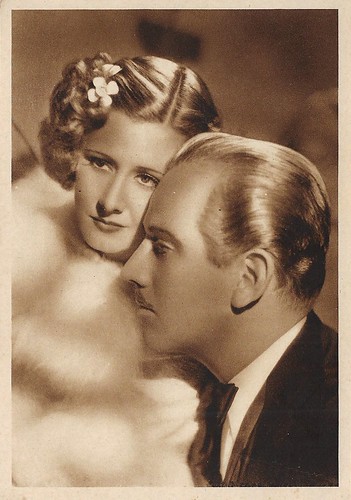
Italian postcard by Vecchioni & Guadagno, Roma. Photo: Columbia EIA. Irene Dunne and Melvyn Douglas in Theodora Goes Wild (Richard Boleslawski, 1936), released in Italy as L'adorabile nemica (The adorable enemy). Collection: Ivo Blom.

Italian postcard by Vecchioni & Guadagno, Roma. Photo: Columbia EIA. Irene Dunne and Melvyn Douglas in Theodora Goes Wild (Richard Boleslawski, 1936), released in Italy as L'adorabile nemica (The adorable enemy). Collection: Ivo Blom.
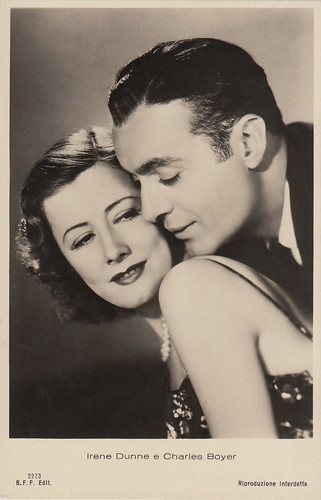
Italian postcard by Ballerini & Fratini, Firenze, no. 3640. Irene Dunne and Charles Boyer in When Tomorrow Comes (John M. Stahl, 1939). Collection: Marlene Pilaete.

Dutch postcard by J.S.A., no. 88. Photo: R.K.O. Radio Pictures. Irene Dunne in Love Affair (Leo McCarey, 1939). Collection: Marlene Pilaete.

American postcard by W.J. Gray. Collection: Marlene Pilaete.

British postcard by Picturegoer, no. W141. Photo: Metro-Goldwyn-Mayer. Collection: Marlene Pilaete.

French postcard by Viny, no. 14. Photo: Metro Goldwyn Mayer. Collection: Marlene Pilaete.

French postcard by Massilia. Photo: Columbia Pictures. Collection: Marlene Pilaete.

Dutch postcard by J.S.A., no. 174. Photo: Universal Film Booking Office. Irene Dunne and Charles Boyer in When Tomorrow Comes (John M. Stahl, 1939). Collection: Marlene Pilaete.

Italian postcard by Rotalfoto, Milano, no. 68. Photo: RKO Radio Films. Collection: Marlene Pilaete.
Later years
A devout Catholic, Irene Dunne increasingly showed a leaning towards civil causes over the years and devoted herself to philanthropic work.
She was an active fund-raiser for the St. John’s Hospital in Santa Monica and supported several other charities as well.
In 1957, President Eisenhower nominated her to be an alternate delegate to the 1957-1958 United Nations General Assembly session.
She was also appointed by Governor Ronald Reagan to serve on the California Art Commission from 1967 to 1970. During her stay, she notably promoted an exhibit offering blind people a tactile view of sculptural art.
Irene Dunne passed away on the 4th of September 1990.

Italian postcard by Garami, Milano. Collection: Marlene Pilaete.

Spanish postcard by Archivo Bermejo, no. 585. Collection: Marlene Pilaete.
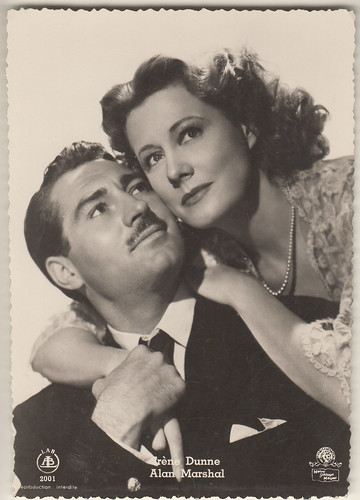
Belgian postcard by Editions L.A.B. Bruxelles, no. 2001. Photo: Metro Goldwyn Mayer. Irene Dunne and Alan Marshall in The White Cliffs of Dover (Clarence Brown, 1944). Collection: Marlene Pilaete.

Italian postcard by B.F.F., Firenze, no. 2118. Photo: Columbia C.E.I.A.D. Collection: Marlene Pilaete.
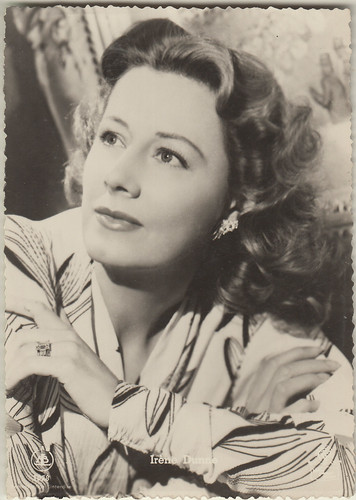
Belgian postcard by Editions L.A.B., Bruxelles, no. 1028. Photo: Metro Goldwyn Mayer. Collection: Marlene Pilaete.

Spanish postcard by Sobe, no. 682. Collection: Marlene Pilaete.

British postcard by Picturegoer, no. D211. Photo: Universal International. Collection: Marlene Pilaete.
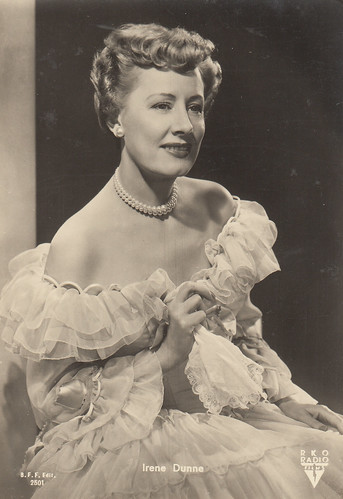
Italian postcard by B.F.F., Firenze, no. 2501. Photo: RKO Radio Films. Collection: Marlene Pilaete.
Text: Marlene Pilaete. This post was last updated on 20 September 2023.
No comments:
Post a Comment